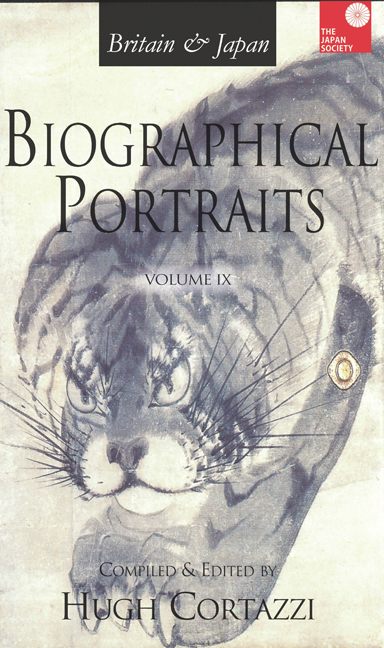Book contents
- Frontmatter
- Contents
- Introduction
- List of Contributors
- Index of Biographical Portraits in Japan Society Volumes
- PART I JAPAN IN BRITAIN: THINGS JAPANESE
- PART II BRITAIN IN JAPAN: TRADE
- BRITISH ACTIVITIES
- MISSIONARIES
- MUSIC, DRAMA AND FILM
- EPISODE
- PAINTERS
- JOURNALISTS
- JAPANESE WOMEN PIONEERS
- PART III SCHOLARS AND WRITERS: JAPANESE
- BRITISH
- PART IV POLITICIANS AND OFFICIALS: JAPANESE
- BRITISH OFFICERS
- BRITISH JUDGES AND A DIPLOMAT
- BRITISH POLITICAL FIGURES
- Index
31 - Ichikawa Sanki (1886-1970): Expert in English Philology and Literature
Published online by Cambridge University Press: 30 April 2022
- Frontmatter
- Contents
- Introduction
- List of Contributors
- Index of Biographical Portraits in Japan Society Volumes
- PART I JAPAN IN BRITAIN: THINGS JAPANESE
- PART II BRITAIN IN JAPAN: TRADE
- BRITISH ACTIVITIES
- MISSIONARIES
- MUSIC, DRAMA AND FILM
- EPISODE
- PAINTERS
- JOURNALISTS
- JAPANESE WOMEN PIONEERS
- PART III SCHOLARS AND WRITERS: JAPANESE
- BRITISH
- PART IV POLITICIANS AND OFFICIALS: JAPANESE
- BRITISH OFFICERS
- BRITISH JUDGES AND A DIPLOMAT
- BRITISH POLITICAL FIGURES
- Index
Summary
INTRODUCTION
ICHIKAWA SANKI is best known for his contribution to the development of English philology in Japan. Eibunpō. Kenkyū. [Studies in English Grammar], his most influential work published in 1912, is often eulogized as the first memorable landmark in its history. ‘ Eibunpō. Kenkyū. marks the starting point of genuinely academic English philology in Japan. The latter half of the Meiji Era, in which the reputation of Saitō Hidesaburō (1866–1929) as an English grammarian reached its peak, can be called the Saitō Era,’ Takanashi Kenkichi, historian of English studies in Japan, writes in his introductory review of English studies in the Taishō Era, ‘so the Taishō Era can be most aptly named the Ichikawa Era.’ Eibunpō. Kenkyū. is Ichikawa's first substantial work in the field of English philology, but the fact that it was published in the very first year of the Taishō Era has tended to tempt many of his biographers to describe this small book as more significantly epoch-making than it really was, just as the symbolism of the figure 3 (san in Japanese), which recurs like a musical motif in the record of his family, has tempted some others to adopt a clear-cut tripartite structure in their accounts of his life. Ichikawa should be portrayed through a fuller account of the multifarious achievements he made in the fields of philology, linguistics, literary explication, specialist education, English language teaching (ELT) and translation.
EARLY YEARS
Ichikawa Sanki was born in Tokyo in 1886, the second son of Ichikawa Sanken who had followed the family tradition of classical Chinese studies and calligraphy and established himself as a professional calligrapher. Sanki himself studied calligraphy and Chinese classics from early childhood under his father's instructions and those of Sanyō, the eldest of the three Ichikawa brothers. He spent most of his time in this culturally refined ambience. During his elementaryschool days he gradually diverged from this family tradition to pursue his self-acquired interest in natural history by collecting plants and insects as well as in visiting museums.
- Type
- Chapter
- Information
- Britain & Japan Biographical Portraits Vol IX , pp. 357 - 367Publisher: Amsterdam University PressPrint publication year: 2015



